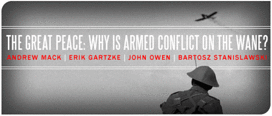Erik Gartzke raises a terrific question concerning nuclear peace. If more countries acquire a second-strike nuclear capability, fewer pairs of countries will fight. Russia has such a capability; China probably has one; India might attain one as its rise continues. If we treat the European Union as a sort of superstate, it has a robust nuclear deterrent as well (in the form of the British and French arsenals). Does this not bode well for the future? As we know, Kenneth Waltz answers in the affirmative.[1]
But I’m not sure optimism is called for. First, one can acknowledge (as I do) that nuclear deterrence has worked without accepting that it must always work. Perhaps a desperate nuclear-armed leader will lapse into irrationality; before committing suicide the (instrumentally) rational Hitler ordered that Germany be destroyed in punishment for its not being worthy of him. Perhaps a failure of command and control, such as that immortalized in Stanley Kubrick’s Dr. Strangelove, could take place. Picture Slim Pickens riding that Bomb as it falls out of the B-52. The rub is that if nuclear deterrence fails only once, the consequences could be unprecedentedly catastrophic. Perhaps there is only a 0.5 percent chance of a failure of deterrence over the next century, but in the case of nuclear weapons we need to distinguish that low figure from zero.
Second, there is the question raised by Bartosz Stanislawski of non-state actors getting hold of a nuclear weapon. Scott Sagan and others have written about the problem of loose nukes – weapons, fissile material, and so on being insecure in some states such as Pakistan or Iran. These could get into the hands of terrorists who are hard to find and hence hard to deter. We know that al Qaeda wants a nuclear weapon. We know about the A.Q. Khan network run out of Pakistan. In other words, I think that Professor Stanislawski’s basic point that catastrophes can happen even during virtuous trends is a good one, especially as concerns nuclear weapons.
While I’m responding, I’ll mention how much I appreciate Erik’s use of centuries of data to show that the trend away from wars is a long-term one. The trends are especially striking because the number of political units, and hence the occasions for war, has increased. This set me thinking about the macro-trends in world history. If the big powers do have less and less incentive to fight, what is reducing their incentives? Was Francis Fukuyama’s “end of History” argument right after all?
Note
[1] See for example Scott D. Sagan and Kenneth N. Waltz, The Spread of Nuclear Weapons: A Debate Renewed (N.Y.: Norton, 2002).

